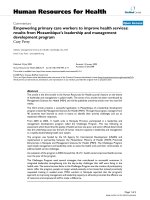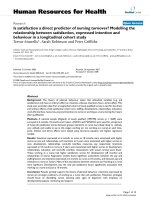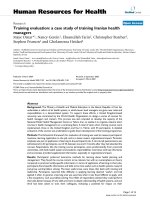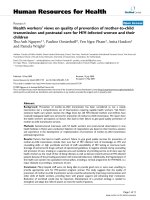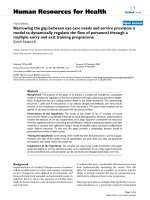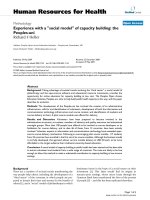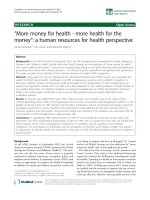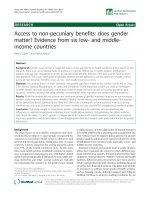Báo cáo sinh học: " Complement component C5a Promotes Expression of IL-22 and IL-17 from Human T cells and its Implication in Age-related Macular Degeneratio" potx
Bạn đang xem bản rút gọn của tài liệu. Xem và tải ngay bản đầy đủ của tài liệu tại đây (1.57 MB, 12 trang )
RESEARCH Open Access
Complement component C5a Promotes
Expression of IL-22 and IL-17 from Human T cells
and its Implication in Age-related Macular
Degeneration
Baoying Liu
1
, Lai Wei
1
, Catherine Meyerle
2
, Jingsheng Tuo
1
, H Nida Sen
1
, Zhiyu Li
1
, Sagarika Chakrabarty
1
,
Elvira Agron
2
, Chi-Chao Chan
1
, Michael L Klein
3
, Emily Chew
2
, Frederick Ferris
2
and Robert B Nussenblatt
1*
Abstract
Background: Age related macular degeneration (AMD) is the leading cause of irreversible blindness in elderly
populations worldwide. Inflammation, among many factors, has been suggested to play an important role in AMD
pathogenesis. Recent studies have demonstrated a strong genetic association between AMD and complement
factor H (CFH), the down-regulatory factor of complement activation. Elevated levels of complement activating
molecules including complement component 5a (C5a) have been found in the serum of AMD patients. Our aim is
to study whether C5a can impact human T cells and its implication in AMD.
Methods: Human peripheral blood mononuclear cells (PBMCs) were isolated from the blood of exudative form of
AMD patients using a Ficoll gradient centrifugation protocol. Intracellular staining and enzyme-linked
immunosorbent assays were used to measure protein expression. Apoptotic cells were detected by staining of cells
with the annexin-V and TUNEL technology and analyzed by a FAC S Caliber flow cytometer. SNP genotyping was
analyzed by TaqMan genotyping assay using the Real-time PCR system 7500.
Results: We show that C5a promotes interleukin (IL)-22 and IL-17 expression by human CD4
+
T cells. This effect is
dependent on B7, IL-1b and IL-6 expression from monocytes. We have also found that C5a could protect human CD4
+
cells from undergoing apoptosis. Importantly, consistent with a role of C5a in promoting IL-22 and IL-17 expression,
significant elevation in IL-22 and IL-17 levels was found in AMD patients as compared to non-AMD controls.
Conclusions: Our results support the notion that C5a may be one of the factors contributing to the elevated
serum IL-22 and IL-17 levels in AMD patients. The possible involvement of IL-22 and IL-17 in the inflammation that
contributes to AMD may herald a new approach to treat AMD.
Background
Age related macular degeneration (AMD) is clinically
characterized by degenerat ive changes in the macula, the
region of the retina that permits fine central vision. One
of the key pathological features of AMD is the develop-
ment of large drusen, extracellular deposits located
between Bruch’ s membrane and the retinal pigment
epithelium (RPE). These large drusen and the associated
RPE changes are the major risk factors for the develop-
ment of advanced AMD, which can be classified into two
subtypes: dry (geographic atrophic) and wet (neovascular)
[1]. Inflammation has been suggested to play an impor-
tant role in AMD pathogenesis [2,3].
Genetic studies have demonstrated strong associations
between AMD and sev eral gene varian ts in genes coding
for complement proteins, including complement factor H
(CFH), factor B/C2, and C3 [4-12]. CFH is a factor that
down-regulates complement activation. It is commonly
thought that CFH polymorphism leads to dysregulation of
alternative complement activation which may contributes
* Correspondence:
1
Laboratory of Immunology, National Eye Institute, National Institutes of
Health, Bethesda, MD 20892, USA
Full list of author information is available at the end of the article
Liu et al. Journal of Translational Medicine 2011, 9:111
/>© 2011 Liu et al; licensee BioMe d Central Ltd. This is an Open Acc ess article distributed under the terms of the Creative Commons
Attribution License ( which permits unrestricted use, distribution, and reproduction in
any medium, provided the original work is properly cited.
to AMD pathogenesis [13]. However, t he mechanism by
which CFH regulates AMD progress is still not clear. Sys-
temic activation of the complement cascade has been
implicated in AMD patients [14-16]. C5a, among man y
alternative complement activation molecules, are elevated
in peripheral blood of AMD patients [15,16]. Locally, C5a
and C3a accumulate in drusen and are shown to promote
choroidal neovascularization (CNV) [17], which is the hall-
mark of wet AMD.
Recently, a subset of effector helper T cells, IL-17-pro-
ducing T cell (Th17), is impl icated in the pathogenesis of
various autoimmune diseases including uveitis, arthritis,
multiple sclerosis, psoriasis and inflammatory bowel dis-
ease [18-20]. Proinflammatory cytokines, including IL-1b,
IL-6, IL-23, IL-21 and TNFa , as well as transcription fac-
tor RORC, are responsible for differentiation and mainte-
nance of Th17 cells within human body [21-24]. Recent
evidence from the mouse suggests that C5a provides
both costimulatory and survival signals to CD4
+
Tcells
and induces Th17 cytokine expression [25,26]. However,
it is still not clear if C5a can impact human T cells and if
Th17 cells are associated with AMD.
Here we showed that C5a protected human CD4
+
T
cells from undergoing apoptosis and C5a promoted IL-22
and IL-17 expression from CD4
+
T cells of AMD patients
and normal subjects as well. Intriguingly, consiste nt with
previous observation of ele vated C5a expression in the
serum of AMD patients [15,16 ], we found significantly
increased levels of IL-22 and IL-17 in the sera of AMD
patients, suggesting possible roles of IL-22 and IL-17 in
the inflammation that contributes to AMD.
Methods
Patients
PBMCs were obtained from the peripheral blood of
AMD patients and healthy subjects in compliance with
institutional review board (IRB) protocols after informed
consent at the National Institutes of Health (NIH). The
written consents were obtained. Our study has obtained
ethics approval from the neuroscience IRB of NIH. AMD
subjects were diagnosed with wet AMD without accom-
panied systemic autoimmune diseases or other immune-
related diseases, as well as polypoidal vasculopathy by
experienced clinicians. We excluded patients with a his-
tory of cancer within the past 5 years or patients with
active inflammatory diseases. Clinical charac teristics,
demographic data, and single-nucleotide polymorphism
information of complement associated molecules are
provided in Table 1 and 2.
Cell sorting
To sort CD 4
+
T cells and monocytes, 1 × 10
7
PBMCs
were stained with all ophycocyan in-labeled CD3 (clon e
UCHT1, BD Biosciences), PE-labeled CD4 (clone RPA-T4,
BD Biosciences), or FITC labeled CD14 (clone M5E2, BD
Biosciences) for 20 minutes in 1% BSA PBS staining buf-
fer. Cells were then washed and subsequently sorted on a
FACS Aria (BD Biosciences). BD FACSDiva software was
used to sort the cells.
Cell culture and flow cytometry
PBMC cells were cultured in RPMI 1640 medium (Invitro-
gen, Carlsbad, CA) containing 10% fetal bovine serum
(Gemini Bioproducts, West Sacramento, CA) supplemen-
ted with 2 mM glut amine and 1× antibiotics. For T cell
and monocytes separation, PBMCs were cultured in the
same RPMI medium described above and then stained
with anti-CD3 and anti-CD4 antibodies for T cell and
anti-CD14 for monocyte separation. Cells were t reated
with or without C5a (50 ng/ml from R&D Systems, endo-
toxin level <1.1 EU per 1 μgofprotein)andaC5aR
antagonist (2.5 ug/ml from Jerini Ophthalmic Inc, also
called JPE-1375, is a hexameric linear peptidomimetic
molecule that inhibits C5a binding to the human C5aR).
Anti-B7.1 and B7.2 antibodies (10 μg/ml of each) or anti-
IL-1b (10 μg/ml) and anti-IL-6 (10 μg/ml) neutralization
antibodies were added into the cell culture in indicated
experiments. Intracellular stai ning was performed after 5
days of C5a culture. Cells were stimulated with PMA (10
ng/ml), ionomycin (0.5 μg/ml) and Golgistop for 4 hours
at 37°C before intracellular staining. 5 × 10
5
cells were
stained with FITC labeled CD45RA (clone HI100, BD
Biosciences), PE-IL-22 (clone 22URTI, eBioscience), or
PE-IL-17A (clone eBio64DEC17, eBioscience), perCP-CD4
(clone SK3, BD Bio sciences) and allophycocyanin-labeled
CD3. The intracellular staining procedure was based on
the BD Bioscience protocol. Briefly, cells were firstly
stained with cell surface markers (anti-CD4, anti-
CD45RA), and then permeabilized and proceeded to intra-
cellular staining (anti-LI-17A or IL-22). Cells were
acquired by a FACSCalibur flow cytometer (BD Bios-
ciences) and analyzed by FlowJo software (TreeStar, San
Jose, CA).
Cytokine Analysis
Sera from p atients or supernatants collected from cell
culture were tested by ELISA for IL-22 and IL-17, or
sent for multiplex cytokine analysis (Aushon Biosys-
tems). IL-22 and IL-17A ELISA kits were purchased
fromR&DSystems,Inc.(Minneapolis,MN)andwere
performed based on kit protocols.
Apoptosis Assay
Apoptotic cells were detected by staining cells with both
the annexin-V-FITC (BD Biosciences) and TUNEL tech-
nology (Roche, Indianapolis, IN) according to the
Liu et al. Journal of Translational Medicine 2011, 9:111
/>Page 2 of 12
Table 1 Clinical information of AMD patients
PT
number
Race, Age,
Gender
Type of
Disease
CFH
rs1061170
C2/CFB
Rs933739
C3
Rs2230199
Ocular therapy+ Co-
Morbidities*
Medications++
1 W, 94, F Wet OU TC GG CC anti-VEGF, PDT 19 H
2 W, 80, F Wet OU TT GG CC anti-VEGF, PDT 8 W, L, X
3 W, 97, F Wet OU TC GG CC anti-VEGF, Isteroids none W
4 W, 92, F Wet OU TC GG CC anti-VEGF 14, 16, 21 Z, G, O, BB
5 W, 91, M Wet OU TC GG CC anti-VEGF 2, 7, 18, 14 W, H, T, G, D, C, B
6 W, 91, M Wet OU TC GG CG anti-VEGF 10, 11, 14, 15 G, C, H, B, E
7 W, 83, F Wet OU CC GG CG anti-VEGF, PDT 8, 14, 16 W, Z, G
8 W, 79, F Wet OD, Dry
OS
CC GG CG anti-VEGF, Laser Rx 14, 15, 21 W, C, G, M, BB
9 W, 74, M Wet OU CC GG GG anti-VEGF, Laser Rx 7, 11, 14, 15 W, BB, E, Y, D, H, L, C, S
10 W, 77, M Wet OD, Dry
OS
TC GG CG anti-VEGF, Isteroids 14, 15 W, L, C, H, R
11 W, 74, M Dry OD, Wet
OS
TT GG CC anti-VEGF 3, 15, 16 W, Z, A
12 W, 82, F Wet OU TT GG GG anti-VEGF, PDT 10, 11 W, E, BB, L, F
13 W, 81, F Wet OU CC GG CG anti-VEGF, laser Rx 7, 14, 15 C, G, V
14 W, 75, M Wet OD, Dry
OS
TC GG CC None 14, 15, 23 C, G, H
15 W, 67, M Wet OD, Dry
OS
TC GG CC anti-VEGF, PDT 8, 15, 20 W, L, X, C, H, F
16 W, 72, F Wet OU TC GG CC anti-VEGF, Isteroids 12, 16 Z, I, G, W
17 W, 74, M Wet OU CC CG GG anti-VEGF, laser Rx,
PDT
20 F, V
18 W, 77, F Wet OU CC - CC anti-VEGF, PDT,
Isteroid
8X
19 W, 75, M Dry OD, Wet
OS
CC GG CC anti-VEGF 11, 15 W, E, C, L
20 W, 82, M Wet OU - - - none 3, 5, 6, 7, 11,
19,
P, B, G, A, E, D
21 W, 72, M Wet OU CC GG CG anti-VEGF, Isteroid 7, 14 H, G, D
22 W, 83, M Wet OD, Dry
OS
TC GG CC anti-VEGF, Isteroid 14, 15 W, L, H, G, C
23 W, 83, M Wet OD, Dry
OS
TT GG GG anti-VEGF, PDT 14, 15, 22 B, W, G, C,
24 W, 88, F Dry OD, Wet
OS
TC GG CC anti-VEGF 19 W, H,
25 W, 70, M Wet OD, Dry
OS
TC GG CC anti-VEGF 10 W
26 W, 83, F Wet OD, Dry
OS
TT GG CC anti-VEGF, Isteroids 8, 13, 14, 17, Q, G, Z, W
27 W, 80, M Dry OD, Wet
OS
CC GG CG anti-VEGF 7, 8, 14, 15, 21,
25
W, L, BB, Q, G, C, M, AA,
D, BB
28 W, 95, M Dry OD, Wet
OS
TT CG CC anti-VEGF 1, 14, 15, 22 W, E, B, K, BB, C, G, T,
29 W, 79, F Wet OU CC GG CG anti-VEGF, PDT 7, 21, 24 W, L, D, V, CC, N
30 W, 84, M Wet OU TC GG CC PDT, Laser Rx 5, 8 G, H, C, X, A,
31 W, 80, M Wet OD, Dry
OS
CC CG CG anti-VEGF 4, 8, 15 W, BB, L, B, E, N, D, X
32 W, 97, F Wet OU - - - None 2 J, B
33 W, 77, M Wet OU TC GG CC anti-VEGF, Laser Rx 11 W, L, E
34 W, 57, M Wet OU, Wet
OS
TT GG CG anti-VEGF 3, 7, 14, 15, 26 A, C, D, G, BB, DD
35 W, 67, F Wet OU CT GG CG anti-VEGF 14, 15, 16, 21 G, M, Z, BB, EE
36 W, 82, F Wet OU CT CG CG anti-VEGF 7, 8, 14, 15, 16 C, G, K, Q, Z, BB
37 W, 84, F Wet OS CC GG CC anti-VEGF 15, 16 CC, L, G, Z,
Liu et al. Journal of Translational Medicine 2011, 9:111
/>Page 3 of 12
manufacturer’s instructions. Phospho-Bad expression
was detected by western blot using anti-Phospho-Bad
antibody (Cell Signaling Technology).
SDS-PAGE and Western blotting
A total of 5 million T cells were lysed in 100 μllysis
buffer [50 mM Tris-Cl, 1% Triton X-100, 100 mM
NaCl, 2 mM EDTA, 50 mM NaF, 50 mM glycerol-phos-
phate, 1 mM NaVO
4
and 1× protease inhibitor cocktail
(Roche)]. Complete cell lysis was achieved by immedi-
ately vortexing the cells and then boiling in an equal
amount of 2 × SDS protein loading buffer at 95°C for 5
minutes. Cell debris was removed by centrifugation at
12, 000 rpm for 3 min. Twenty microliter of each sam-
ple was loaded into a 12% SDS-polyacrylamide gel con-
taining a 4% stacking gel. Immunoblotting was carried
out. Primary antibodies of anti-Phospho-Bad, anti-Bad
were purchased from Cell Signaling Technology (Bev-
erly, MA). Anti-b-actin antibody was from Santa Cruz
Biotechnology, Inc.(Santa Cruz, CA).
SNP Genotyping
Genomic DNA was extracted from the peripheral blood
of each individual using Promega Wizard Genomic DNA
Purification kit. The samples were analyzed by TaqMan
genotyping assay using the Real-time PCR system 7500
(Applied Biosystems, Foster City, CA, USA). The primers
and probes for C2/CFB rs9332739 and C3 rs223 0199
were from the inventory SNP assay while CFH rs1061170
were custom-designed from Applied Biosystems. Geno-
types were determined based on the fluorescence intensi-
ties of FAM and VIC. The call rates of 3 assays were
>98.5% and the call accuracies (consistency of duplicate
wells of selected samples) were 100%.
Statistical Analysis
Non-parametric methods (Wilcoxon two-sample test)
were used since the expression of IL17 and IL22 does
not follow a parametric distribution. To evaluate if the
expression of these 2 cytokines follows a normal distri-
bution, we visually checked the histograms as well as
used the Kolmogorov-Smirnov method. For the associa-
tion study between IL-22/IL-17 and some characteristics
of patients (CFH, C2/CFB, C3 genotypes, gender, co-
morbidities of diabetes, hypertension and hypercholes-
terolemia), Wilcoxon’s nonparametric two-sample rank
sum test was used. Age was analyzed using Pearson cor-
relation. The software used for all the analyses was “The
SAS System”, version 9.2.
Results
We listed the demographic, clinical info rmation for both
controls and AMD patients in Table 1 and Table 2. Ocular
therapies, co-morbidities and complement related genetic
variance were also included to AMD patients for later data
analysis. These information will be used to evaluate con-
founding factors. All the subjects in this study are Cauca-
sians. There are 45 controls and the age range was from
59 to 87. Fifty-three percent (53%) are females and 47%
are males. There are 40 AMD patients in this study and
the age range was from 57 to 97. Fifty percent (50%) are
females and 50% are males.
C5a promotes the expression of IL-22 and IL-17 from
human T cells in vitro
To study the role of C5a on human CD4
+
T cells, we
used E LISA and intracellular staining to detect cytokine
expression. PBMCs from AM D patients and controls
were treated with or without C5a and a C5aR antagonist
for 3 days. Cell supernatants from 14 controls and 14
AMD patients were used for ELISA analysis and are pre-
sented side by side in Figure 1A. The addition of C5a
greatly increased the expression of IL-22 and IL-17A in
PBMC cells from both AMD patients and controls.
Blocking C5aR reversed this effect (Figure 1A). Interest-
ingly, we cannot detect the changes of IFN and IL-4
Table 1 Clinical information of AMD patients (Continued)
38 W, 83, F Wet OU CT GG CG anti-VEGF 9, 14, 15, 28 B, C, BB
39 W, 84, F Wet OS TT GG CC anti-VEGF 16, 27 Z, CC
40 W, 90, F Wet OU CC GG CC anti-VEGF 27 B, G, H, O, BB, CC
Ocular therapy+
anti-VEGF- either Lucentis or Avastin intravitreal injections; Isteroids-Intravitreal steroid inject ions; PDT- Photodynamic
therapy; Laser Rx- focal laser ablation of choroidal neovascularization
Co-morbidities*
1. anemia; 2. atrial fibrillation; 3. benign prostatic hypertrophy; 4. cerebrovascular accident; 5. COPD; 6. coronary artery disease; 7. depression; 8. diabetes; 9. Colon
Cancer; 10. Glaucoma; 11. GERD; 12. gout; 13. Hashimoto’ s thyroiditis; 14. hypertension; 15. hypercholesterolemia; 16. hypothyroid; 17. h/o low grade vitritis; 18.
Lyme Disease; 19. myocardial infarction; 20. Ocular Hypertension; 21. osteoporosis; 22. pacemaker; 23. prostate cancer; 24. seasonal allergies 25. testicular failure;
26. Asthma; 27. Uterine cancer post hysterectomy and radiation 28: Breast cancer.
Medications++
A. Anti-Benign Prostatic Hypertrophy; B. Anti-Coagulants; C. Anti-Cholesterol; D. Anti-Depressants; E. Anti-GERD; F. Anti-Glaucoma drops; G. Anti-Hypertensive
medication; H. Aspirin; I. Colchicine; J. Digoxin; K. Ferrous Fumarate; L. Fish Oil; M. Fosamax; N. Gapapent in; O. Glucosamine; P. Inhalers; Q. Insulin; R. Loratad ine; S.
Magnesium Citrate; T. Meclizine; U. Megestrol acetate; V. NSAIDs; W. Ocuvites; X. Oral Hypoglycemic agents; Y. Scopo lamine; Z. Synthroid; AA. Testosterone
injections; BB. Vitamins; CC. Premarin; DD. Singulair; EE. Calcitonin.
Liu et al. Journal of Translational Medicine 2011, 9:111
/>Page 4 of 12
levels before and after C5a treatment. We then s ub-
grouped the C5a induced IL-22/IL-17 expression in both
controls and AMD pa tients based on their CFH SNP
information (rs1061170). As sh own in Figure 1B, there
was no significant difference on cytokine expression
between controls and AMD patients. How ever, C5a high
response individuals all have the risk CFH allele genotype
(heterozygous/homozygous, TC/CC) in both control and
patient groups. Intracellularstainingdatafurthercon-
firmed that C5a induced IL-22 and IL-17A secretion
from cultured CD3
+
CD4
+
T cells after PBMCs wer e trea-
ted for 5 days (Figure 1C).
Monocytes are important for C5a induced IL-22 and IL-17
expression from T cells
To address if peripheral monocytes play a role in C5a
induced IL-22 and IL-17 expression of CD4
+
T cells,
CD14
+
monocytes and CD3
+
CD4
+
T cells were cultured
separately or together, with or without C5a (50 ng/ml)
for 72 hours. Protein levels of IL-22 and IL-17A in the
culture supernatants were detected by ELISA. As sho wn
in Figure 2A, IL-22 and IL-17 were barely detected in
cultures with monocytes or CD4
+
T cells alone. Interest-
ingly, C5a induced expression of both cytokines only in
co-cultures of CD4
+
T cells and monocytes, suggesting
that monocytes are necessary for C5a to promote IL-22
and IL-17 expression. Further experiments showed that
only memory CD4
+
T cells, when co-cultured with
monocytes, could produce Th17 cytokines (Figure 2B).
The effects of monocytes on T cells could be due to
either direct interaction between B7.1/B7.2 on monocytes
and CD28 on T cells, or indirect effects such as the pro-
duc tion of cytokines. C5a treatment promoted both B7.1
and B7.2 expression on monocytes (Figure 2C). When a
blocking antibody that interrupts the B7-CD28 interac-
tion was added to the culture, the induction of both IL-
22 and IL-17 by C5a was diminished, to a similar extent
as the effect seen with the C5aR antagonist (Figure 2D).
Previous studies have shown that IL-1b and IL-6 are dri-
vers of Th17 cell polarization [22,27,28]. We found a sig-
nificantly increased expres sion of both IL-1b and IL-6 in
the supernatants of co-cultures containing both mono-
cytes and T cells and an increased trend for TNF-a
although P value not significant (Figure 2E), but not IFN-
or IL-23. Both IL-1b and IL-6 were produced by mono-
cytes (Figure 2F). We therefore neutralized IL-1b and
IL-6 with neutralizing antibodies and found that the
induction of I L-22 and IL-17 by C5a were significantly
dampened (Figure 2G). Collectively, our results indicate
that not only direct interaction between monocytes and
T cells, but also the secretion of IL-1b and IL-6 by mono-
cytes is required for promotion of Th17 cytokines
by C5a.
C5a protects T cells from undergoing apoptosis
To fully understand the overall effect of C5a on CD4
+
T
cells, we examined C5a’s effect on CD4
+
T cell survival.
Purified PBMC cells naturally undergo apoptosis in
Table 2 Healthy Donor Information
Donor
number
Race, Age,
Gender
CFH
rs1061170
C2/CFB
Rs9332739
C3
Rs2230199
1 W, 61, F CT CG CC
2 W, 72, M CT GG CC
3 W, 69, M - GG GG
4 W, 71, F CT GG CG
5 W, 75, M TT GG CC
6 W, 65, F TT GG CC
7 W, 66, F TT GG CC
8 W, 66, M CT GG CC
9 W, 73, M TT GG CC
10 W, 61, M CC GG CC
11 W, 69, M TT GG CG
12 W, 73, F CT GG CC
13 W, 65, F CT GG CC
14 W, 75, F CT GG CC
15 W, 69, M CT GG CC
16 W, 65, F CC GG GG
17 W, 65, F CT GG CC
18 W, 65, F - CG CG
19 W, 62, F TT CG CC
20 W, 71, M TT GG CG
21 W, 72, M CT GG CC
22 W, 62, M TT GG CC
23 W, 71, F CC GG CG
24 W, 66, F TT GG CG
25 W, 65, F CT GG CC
26 W, 61, F CT GG CC
27 W, 63, F CT CG CC
28 W, 64, F CT GG CC
29 W, 68, M CT CG CG
30 W, 70, M CT GG -
31 W, 87, F - - -
32 W, 59, M CC CC CC
33 W, 64, F - - CC
34 W, 61, M TT GG CG
35 W, 66, M CC CG CG
36 W, 65, M CC GG CG
37 W, 65, F CT GG GG
38 W, 60, F CT GG CG
39 W, 63, F TT GG CG
40 W, 66, F CT CC CC
41 W, 77, F - - -
42 W, 65, M CT GG CC
43 W, 66, M CT GG CG
44 W, 62, M CT GG CC
45 W, 66, M - - -
Liu et al. Journal of Translational Medicine 2011, 9:111
/>Page 5 of 12
Figure 1 C5a pr omotes the expression of IL-22 and IL-17 from T cells. (A) IL-22 and IL-17 in 3-day culture supernatants of PBMCs from 14
AMD patients and 14 controls. (B) C5a induced IL-22/IL-17 expression in both controls and AMD patients were subgrouped based on CFH
genotypes. (C) Intracytoplasmic staining of IL-22 and IL-17 from both controls and AMD patients after 5 days of culture with or without C5a and
C5aR antagonist.
Liu et al. Journal of Translational Medicine 2011, 9:111
/>Page 6 of 12
culture and they usually die without stimulation in 7
days. We added C5a with or without the C5aR antagonist
to the culture for 2 days and compared the percentage of
cells undergoing apoptosis for more than 10 individuals.
Morphological signs of the inhibition of apoptosis,
including more c ell aggregates and less shrunken cells,
were observed in C5a group. Figure 3A represen ts a typi-
cal flow cytometry scatter plot. The percentages of lym-
phocyte and monocyte gates increased after C5a
treatment (from 41% to 52.8% and 5.96% to 17.0%
respectively). Further apoptosis staining showed that the
addition of C5a prevented CD4
+
T cells from undergoing
apoptosis, as indicated by annexin V staining. This effect
was abr ogated by the addition of a C5aR antagonist
(Figure 3B). TUNEL staining confirmed these results.
Apoptotic cells were labeled with fluorescein. Fluorescein
labeled cells had less intense staining in C5a treatment
group as c ompared to the contro l group (Figure 3C ).
Figure 2 IL-1b and IL-6 secreting monocytes are important for C5a induced IL-22 and IL-17 expression form T cells. (A) CD3
+
CD4
+
T (T)
cells and CD3
-
CD14
+
monocytes (M) were sorted and cultured with or without C5a for 3 days. Cell supernatants were assessed for IL-22 and IL-
17 expression. Three separate experiments were performed and the figure shows representative data. (B) CD3
+
CD4
+
CD45RA
+
(naïve T cells, nT)
and CD3
+
CD4
+
CD45RA
-
(memory T cells, mT) T cells and CD3
-
CD14
+
monocytes (M) were sorted and cultured with or without C5a for 3 days. IL-
22 and IL-17 levels were measured from supernatants. Three separate experiments were performed and the figure shows representative data. (C)
C5a activates B7 expression on monocytes. PBMCs were cultured with or without C5a for 1 day. CD3
-
CD14
+
monocytes were gated for indicated
cell markers’ expression. Similar results were seen in another independent assay. (D) IL-22 and IL-17 in 3-day culture supernatants of PBMCs with
the presence or absence of C5a, C5aR antagonist and anti-B7.1 and anti-B7.2 antibodies. (E) C5a stimulates monocytes to secrete IL-1b and IL-6.
PBMCs were cultured with or without C5a and C5aR antagonist for 3 days. Cell supernatants were assayed for IL-1b, IL-6 and TNFa expression.
(F) Monocytes and T cells were sorted and cultured with or without C5a for 3 day. Cell supernatants were assayed for IL-1b and IL-6 expression.
Three separate experiments were performed and the figure shows representative data. (G) IL-22 and IL-17 in 3-day culture supernatants of
PBMCs with the presence or absence of C5a with isotype control antibody, C5aR antagonist and anti-IL-1b and anti-IL-6 neutralization antibodies.
Three separate experiments were performed.
Liu et al. Journal of Translational Medicine 2011, 9:111
/>Page 7 of 12
Figure 3 C5a protects T cells from undergoing apoptosis. (A) Scatter plot of PBMCs cultured with or without C5a. Three separate
experiments were performed and the figure shows representative data. (B) Annexin V expression on T cells cultured with or without C5a and
C5aR antagonist. Ten separate experiments were performed and the figure shows representative data. (C) TUNEL staining of CD4
+
T cells treated
with or without C5a and C5aR antagonist. (D) PBMCs were treated with or without C5a for 2 days. T cells were sorted and processed for western
blot analysis for indicated antibodies. Densitometry graph is also shown. Similar results were seen in another independent assay.
Liu et al. Journal of Translational Medicine 2011, 9:111
/>Page 8 of 12
Moreover, the expression of Phospho-Bad, one of the
anti-apoptotic indicators, wa s increased in CD4
+
Tcells
after C5a treatment (Figure 3D).
Higher IL-22 and IL-17 expression in AMD patients
Different cohort studies have shown elevated levels of
C5a in AMD blood as compared to controls [15,16].
Based on our in vitro data that C5a induced Th17 cyto-
kine expression from human T cells, we want to do a
pilot study to evaluate the expression of IL-22 and IL-17
in the serum of AMD patients. As shown in Figure 4,
IL-22 and IL-17 levels were significantly elevated in
AMD patients compared with controls. We then sub-
grouped cytokine e xpression in both the contro ls and
the AMD pat ients based on their CFH SNP information
(rs1061170). As shown in Figure 4, IL-22/IL-17 cytokine
high expression AMD patients have the risk CFH allele
genotypes (heterozygous/homozygous, TC/CC). How-
ever, for control group, IL-22/IL-17 expressions
remained low regardless of their CFH SNP genotypes.
We performed the association study between IL-22/IL-
17 cytokine expressions and some characteristics of
patients (CFH, C2/CFB, C3 genotypes, age, gender, co-
morbidities of diabetes, hypertension and hypercholes-
terolemia). Our results indicated that there were no
statistically significant associations between IL-22 /IL -17
cytokine expressions and these var iances (all P values
are more than 0.05, Additional file 1: Table S1).
Figure 4 IL-22 and IL-17 present a higher expression in AMD patients. Sera from 29 controls and 25 AMD patients were assayed for IL-22.
Thirty (30) controls and 23 AMD patients was assayed for IL-17 expression. IL-22/IL-17 expression in both controls and AMD patients were
subgrouped based on the subjects’ CFH genotypes.
Liu et al. Journal of Translational Medicine 2011, 9:111
/>Page 9 of 12
Discussion
In this study, we have provided evidence that C5a
induced IL-22 and IL-17A expression from human CD4
+
T cells. Importantly, consistent with previous observa-
tions of elevated C5a expression in the serum of AMD
patients from different cohorts [15,16], we observed sig-
nificantly increased levels of IL-22 and IL-17A in the sera
of AMD patients. However, so far, we do not have direct
evidence showing that the elevated Th17 cytokine levels
in AMD patients’ sera are due to higher C5a expression
in AMD patients. C5a may be one of the many factors
related to this observed effect. Other unknown factors
may also contribute to this T cell activation seen in AMD
patients. Interestingly, the findings that C5a specifically
promoted the Th17 family cytokine production, but not
IFN nor IL-4, also correlate d with the fact that there
were similar IFN and IL-4 levels i n the sera of AMD
patients as compared to controls. The dysregulation of
the complement system has been linked to multiple neu-
rodegenerative diseases including Alzheimer’ sdisease,
Parkinson’s disease, as well as AMD [29]. The induction
of inflammatory Th17 cytokines, including IL-22 and IL-
17, by complement component C5a could potentially elu-
cidate the general mechanism by w hich inflammation
contributes to the pathogenesis of these diseases pre-
viously referred to as degenerative. Our resul ts support a
role for C5a in protecting CD4
+
T cells from undergoing
apoptosis (Figure 3). These findings suggest that the
enhanced effector T cell function by C5a is at least par-
tially mediated by limiting pro-inflammatory cell death.
We found that monoctytes are necessary for C5a
induced Th17 cytokine production through two mechan-
isms: 1) promoting the direct interaction betwee n mono-
cytes and T cells; 2) indirectly stimulating the production
of IL-1b and IL-6 from monocytes. C5a can bind to the
trans-membrane recept ors C5aR/CD88 and C5L2
(GPR77) which are expressed on monocytes. C5L2 is
expressed at much lower levels as compared to CD88.
C5a binding to CD88 leads to a number of functional
changes including activation of inflammation. However,
the pathophysiological role of C5L2 is currently contro-
versial with both pro-inflammatory and anti-inflamma-
tory roles reported [30]. Previous reports from rodent
models have shown that C5a has a direct effect on T cells
by interacting with the C5a receptor expressed on T
cells, a finding which is different from what we have
observed in humans [26]. Fang et al. recently demon-
strated that C5a itself has no effect on Th17 cytokine
producti on in mouse [31]. However, C5a synergizes with
TLR4 to produce serum factors that drive Th17 cell dif-
ferentiation [31]. Liu et al.reportedthatlocalinterac-
tions among C3a/C5a, C3aR/C5aR, antigen presenting
cells (APC) and T cells are important for IFN and IL-17
production of T cells in a murine EAE (Experimental
autoimmune encephalomyelitis) model [32]. In another
murine sepsis model, Xu et al. shows that C5a affects the
crosstalk between DC and gamma/delta T cells and
results in a large production of IL-17[33]. In a human
study, Hueber and colleagues showed that C5a induces
IL-17 from human mast cells [34]. Our work is the first
human study showing that monocytes play an essential
role in C5a promoted expression of Th17 cytokines from
CD4
+
T cells.
Several research t eams have reported that a common
SNP of CFH, Tyr
402
His, has a particularly strong asso-
ciation with AMD [4,6,8]. We sub-grouped IL-22/IL-17
expression based on the subjects’ CFH SNP genotypes
and found that AMD patients with higher IL-22/IL-17
cytokine expression were likely to have the risk CFH
allele (TC/CC) (Figure 4). However, serum IL-22/IL-17
cytokine levels showed no difference between the two
CFH genotype groups (TT versus TC/CC) in controls.
These results suggest that this CFH SNP does not
explain the elevated Th17 cytokine expression. However,
thisgeneticvariantmaybeoneofthemanyfactors
influencing Th17 cytokine expression.
Dysregulation of alternative complement activation has
been reported to be involved in AMD patho genesis. The
drusen of AMD donor eyes contain almost all molecules
of the alternative complement pathway, including CFH,
C3, C5, C3a, C5a, and the membrane attack complex
(MAC) [35-37]. These results suggest the role of the com-
plement system in the eye. The products of com plem ent
activation can also be detected in the b lood of AMD
patients. Scholl et al. [16] found higher levels of alternative
complement activation molecules in the blood from an
AMD cohort, including Ba, C3d, MAC, C3a, and C5a. A
subsequent study in a larger independent cohort of
patients and controls confirmed these results, showing the
activation of the alternative pathway of complement in
blood is associated with genetic polymorphisms in com-
plement factor B and increases with age [14]. Reynolds
and colleagues also found an increased plasma concentra-
tion of C5a and Bb in advanced AMD [15]. In addition, a
recent report has shown that immunization with carbox-
yethylpyrrole generated by oxidative damage to DHA
(Docosahexaenoic acid) present in the drusen and plasma
from AMD-affected individuals is sufficient to produce
AMD like lesions in mice and antibody titers of carbox-
yethylpyrrole correlates with disease pathology, suggesting
the involvement of the acquired immune pathway in dis-
ease pathology [38]. In this study, we found C5a induced
Th17 cytokine expression from human T cells in vitro,
which correlates with the increased levels of Th17 cyto-
kines in AMD blood. IL-22 has been shown to induce
apoptosis of fetal retinal pigment epithelium (RPE) cells
Liu et al. Journal of Translational Medicine 2011, 9:111
/>Page 10 of 12
and reduce RPE cell electrical resistance in culture [39].
However, whether systemic observations reflects patholo-
gical events in the eye and how systemic activation may
ultimately be manifest in the eye remain to be defined.
To date there is no effective treatments other than
attempts to slow the progress ion of geo graphic atrophy
form of AMD, while neovascular AMD is treated with
anti-VEGF medications injected directly into the eye
[40,41]. Previous attempts at controlling the wet form of
AMD with c orticost eroid therapy have shown that the
beneficial effect is transient with a significant side-effect
risk profile [42]. Health impr oving behavior (no-sm ok-
ing), diet, and exercise may be preventive measures for
AMD [43]. Several compounds targeting complement
pathway are currently in clinical trials [13]. We recently
reported that immunotherapy directed against T-cell
activation resulted in patients with recurrent CNV
requiring fewer injections of anti-VEGF [44]. The dysre-
gulation of the acquired immune pathway we describe
here may provide us with new therapeutic strategies.
Conclusion
Inconclusion,wehaveshownthatC5apromoted
expression of Th17 cytokines from human CD4
+
T cells.
Consistent with several cohort observation of elevated
C5a expression in the serum of AMD patients [14-16],
our results support the notion that C5a may be one of
the factors contributing to the elevated serum IL-22 and
IL-17 levels in AMD patients. Targeting adaptive
immune system, more specifically the Th17 family of
cytokines, may have beneficial effect on the course of
AMD.
Additional material
Additional file 1: Table S1 Association between the serum levels of
IL-22/IL-17 with patients’ characteristics. P values were listed for the
association between IL-22/IL-17 and some characteristics of patients
(CFH, C2/CFB, C3 genotypes, gender, co-morbidities of diabetes,
hypertension and hypercholesterolemia). Age was analyzed using
Pearson correlation.
Abbreviations
AMD: Age related macular degeneration; CFH: complement factor H; IL:
interleukin; RPE: retinal pigment epithelium; PBMC: peripheral blood
mononuclear cell; SNP: single nucleotide polymorphism
Acknowledgements
We thank Dr. Anthony Adamis for kindly providing the C5aR antagonist;
Rafael Villasmil for assistance with flow cytometric cell sorting; This research
was supported by the Intramural Research Program of NIH, National Eye
Institute.
Author details
1
Laboratory of Immunology, National Eye Institute, National Institutes of
Health, Bethesda, MD 20892, USA.
2
Division of Epidemiology and Clinical
Research, National Eye Institute, National Institutes of Health, Bethesda, MD
20892, USA.
3
Macular Degeneration Center and Leonard Christensen Eye
Pathology Laboratory, Casey Eye Institute, Oregon Health & Science
University, Portland, OR 97239, USA.
Authors’ contributions
BL, RBN have conceived and designed the research and drafted the
manuscript; BL, LW, JT, ZL, SC have performed the experiments. CM, HNS,
CCC, MLK, EC, FF have provided materials and clinical samples and help
analyzed the clinical data. EA, BL performed statistical analysis. All authors
read and approved the final manuscript.
Competing interests
The authors declare that they have no competing interests.
Received: 13 May 2011 Accepted: 15 July 2011 Published: 15 July 2011
References
1. Ferris FL, Fine SL, Hyman L: Age-related macular degeneration and
blindness due to neovascular maculopathy. Arch Ophthalmol 1984,
102:1640-1642.
2. Nussenblatt RB, Liu B, Li Z: Age-related macular degeneration: an
immunologically driven disease. Curr Opin Investig Drugs 2009, 10:434-442.
3. Patel M, Chan CC: Immunopathological aspects of age-related macular
degeneration. Semin Immunopathol 2008, 30:97-110.
4. Edwards AO, Ritter R, Abel KJ, Manning A, Panhuysen C, et al: Complement
factor H polymorphism and age-related macular degeneration. Science
2005, 308:421-424.
5. Gold B, Merriam JE, Zernant J, Hancox LS, Taiber AJ, et al: Variation in
factor B (BF) and complement component 2 (C2) genes is associated
with age-related macular degeneration. Nat Genet 2006, 38:458-462.
6. Hageman GS, Anderson DH, Johnson LV, Hancox LS, Taiber AJ, et al: A
common haplotype in the complement regulatory gene factor H (HF1/
CFH) predisposes individuals to age-related macular degeneration. Proc
Natl Acad Sci USA 2005, 102:7227-7232.
7. Jakobsdottir J, Conley YP, Weeks DE, Ferrell RE, Gorin MB: C2 and CFB
genes in age-related maculopathy and joint action with CFH and
LOC387715 genes. PLoS One 2008, 3:e2199.
8. Klein RJ, Zeiss C, Chew EY, Tsai JY, Sackler RS, et al: Complement factor H
polymorphism in age-related macular degeneration. Science 2005,
308:385-389.
9. Maller JB, Fagerness JA, Reynolds RC, Neale BM, Daly MJ, et al: Variation in
complement factor 3 is associated with risk of age-related macular
degeneration. Nat Genet 2007, 39:1200-1201.
10. Spencer KL, Hauser MA, Olson LM, Schmidt S, Scott WK, et al: Protective
effect of complement factor B and complement component 2 variants
in age-related macular degeneration. Hum Mol Genet 2007, 16:1986-1992.
11. Spencer KL, Olson LM, Anderson BM, Schnetz-Boutaud N, Scott WK, et al:
C3 R102G polymorphism increases risk of age-related macular
degeneration. Hum Mol Genet 2008, 17:1821-1824.
12. Yates JR, Sepp T, Matharu BK, Khan JC, Thurlby DA, et al: Complement C3
variant and the risk of age-related macular degeneration. N Engl J Med
2007,
357:553-561.
13.
Charbel Issa P, Chong NV, Scholl HP: The significance of the complement
system for the pathogenesis of age-related macular degeneration -
current evidence and translation into clinical application. Graefes Arch
Clin Exp Ophthalmol 2011, 249:163-174.
14. Hecker LA, Edwards AO, Ryu E, Tosakulwong N, Baratz KH, et al: Genetic
control of the alternative pathway of complement in humans and age-
related macular degeneration. Hum Mol Genet 2010, 19:209-215.
15. Reynolds R, Hartnett ME, Atkinson JP, Giclas PC, Rosner B, et al: Plasma
complement components and activation fragments: associations with
age-related macular degeneration genotypes and phenotypes. Invest
Ophthalmol Vis Sci 2009, 50:5818-5827.
16. Scholl HP, Charbel Issa P, Walier M, Janzer S, Pollok-Kopp B, et al: Systemic
complement activation in age-related macular degeneration. PLoS One
2008, 3:e2593.
17. Nozaki M, Raisler BJ, Sakurai E, Sarma JV, Barnum SR, et al: Drusen
complement components C3a and C5a promote choroidal
neovascularization. Proc Natl Acad Sci USA 2006, 103:2328-2333.
18. Caspi R: Autoimmunity in the immune privileged eye: pathogenic and
regulatory T cells. Immunol Res 2008, 42:41-50.
Liu et al. Journal of Translational Medicine 2011, 9:111
/>Page 11 of 12
19. Weaver CT, Hatton RD, Mangan PR, Harrington LE: IL-17 family cytokines
and the expanding diversity of effector T cell lineages. Annu Rev
Immunol 2007, 25:821-852.
20. Zheng Y, Danilenko DM, Valdez P, Kasman I, Eastham-Anderson J, et al:
Interleukin-22, a T(H)17 cytokine, mediates IL-23-induced dermal
inflammation and acanthosis. Nature 2007, 445:648-651.
21. Manel N, Unutmaz D, Littman DR: The differentiation of human T(H)-17
cells requires transforming growth factor-beta and induction of the
nuclear receptor RORgammat. Nat Immunol 2008, 9:641-649.
22. Volpe E, Servant N, Zollinger R, Bogiatzi SI, Hupe P, et al: A critical function
for transforming growth factor-beta, interleukin 23 and proinflammatory
cytokines in driving and modulating human T(H)-17 responses. Nat
Immunol 2008, 9:650-657.
23. Wilson NJ, Boniface K, Chan JR, McKenzie BS, Blumenschein WM, et al:
Development, cytokine profile and function of human interleukin 17-
producing helper T cells. Nat Immunol 2007, 8:950-957.
24. Yang L, Anderson DE, Baecher-Allan C, Hastings WD, Bettelli E, et al: IL-21
and TGF-beta are required for differentiation of human T(H)17 cells.
Nature 2008, 454:350-352.
25. Lalli PN, Strainic MG, Yang M, Lin F, Medof ME, et al: Locally produced C5a
binds to T cell-expressed C5aR to enhance effector T-cell expansion by
limiting antigen-induced apoptosis. Blood 2008, 112:1759-1766.
26. Strainic MG, Liu J, Huang D, An F, Lalli PN, et al: Locally produced
complement fragments C5a and C3a provide both costimulatory and
survival signals to naive CD4+ T cells. Immunity 2008, 28:425-435.
27. Acosta-Rodriguez EV, Napolitani G, Lanzavecchia A, Sallusto F: Interleukins
1beta and 6 but not transforming growth factor-beta are essential for
the differentiation of interleukin 17-producing human T helper cells. Nat
Immunol 2007, 8:942-949.
28. Bradshaw EM, Raddassi K, Elyaman W, Orban T, Gottlieb PA, et al:
Monocytes from patients with type 1 diabetes spontaneously secrete
proinflammatory cytokines inducing Th17 cells. J Immunol 2009,
183:4432-4439.
29. Yanamadala V, Friedlander RM: Complement in neuroprotection and
neurodegeneration. Trends Mol Med 2010, 16:69-76.
30. Woodruff TM, Nandakumar KS, Tedesco F: Inhibiting the C5-C5a receptor
axis. Mol Immunol 2011.
31. Fang C, Zhang X, Miwa T, Song WC:
Complement promotes the
development of inflammatory T-helper 17 cells through synergistic
interaction with Toll-like receptor signaling and interleukin-6 production.
Blood 2009, 114:1005-1015.
32. Liu J, Lin F, Strainic MG, An F, Miller RH, et al: IFN-gamma and IL-17
production in experimental autoimmune encephalomyelitis depends on
local APC-T cell complement production. J Immunol 2008, 180:5882-5889.
33. Xu R, Wang R, Han G, Wang J, Chen G, et al: Complement C5a regulates
IL-17 by affecting the crosstalk between DC and gammadelta T cells in
CLP-induced sepsis. Eur J Immunol 2010, 40:1079-1088.
34. Hueber AJ, Asquith DL, Miller AM, Reilly J, Kerr S, et al: Mast cells express
IL-17A in rheumatoid arthritis synovium. J Immunol 2010, 184:3336-3340.
35. Anderson DH, Radeke MJ, Gallo NB, Chapin EA, Johnson PT, et al: The
pivotal role of the complement system in aging and age-related
macular degeneration: hypothesis re-visited. Prog Retin Eye Res 2010,
29:95-112.
36. Crabb JW, Miyagi M, Gu X, Shadrach K, West KA, et al: Drusen proteome
analysis: an approach to the etiology of age-related macular
degeneration. Proc Natl Acad Sci USA 2002, 99:14682-14687.
37. Johnson LV, Leitner WP, Staples MK, Anderson DH: Complement activation
and inflammatory processes in Drusen formation and age related
macular degeneration. Exp Eye Res 2001, 73:887-896.
38. Hollyfield JG, Bonilha VL, Rayborn ME, Yang X, Shadrach KG, et al: Oxidative
damage-induced inflammation initiates age-related macular
degeneration. Nat Med 2008, 14:194-198.
39. Li Z, Liu B, Maminishkis A, Mahesh SP, Yeh S, et al: Gene expression
profiling in autoimmune noninfectious uveitis disease. J Immunol 2008,
181:5147-5157.
40. Hubschman JP, Reddy S, Schwartz SD: Age-related macular degeneration:
current treatments. Clin Ophthalmol 2009, 3:155-166.
41. Ranibizumab and Bevacizumab for Neovascular Age-Related Macular
Degeneration. N Engl J Med 2011.
42. Kiernan DF, Mieler WF: The use of intraocular corticosteroids. Expert Opin
Pharmacother 2009, 10:2511-2525.
43. Wong IY, Koo SC, Chan CW: Prevention of age-related macular
degeneration. Int Ophthalmol 2011,
31:73-82.
44. Nussenblatt RB, Byrnes G, Sen N, Yeh S, Faia L, et al: A randomized pilot
study of systemic immunosuppression in the treatment of age-related
macular degeneration with choroidal neovascularization. Retina 2010,
30:1579-1587.
doi:10.1186/1479-5876-9-111
Cite this article as: Liu et al.: Complement component C5a Promotes
Expression of IL-22 and IL-17 from Human T cells and its Implication in
Age-related Macular Degeneration. Journal of Translational Medicine 2011
9:111.
Submit your next manuscript to BioMed Central
and take full advantage of:
• Convenient online submission
• Thorough peer review
• No space constraints or color figure charges
• Immediate publication on acceptance
• Inclusion in PubMed, CAS, Scopus and Google Scholar
• Research which is freely available for redistribution
Submit your manuscript at
www.biomedcentral.com/submit
Liu et al. Journal of Translational Medicine 2011, 9:111
/>Page 12 of 12
